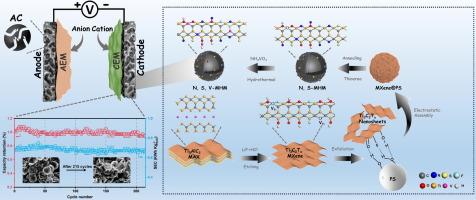当前位置:
X-MOL 学术
›
J. Adv. Res.
›
论文详情
Our official English website, www.x-mol.net, welcomes your
feedback! (Note: you will need to create a separate account there.)
Defect passivation and transformation of Ti3C2Tx MXene hollow microsphere for superior electrochemical performance and sodium-ions storage
Journal of Advanced Research ( IF 11.4 ) Pub Date : 2025-06-03 , DOI: 10.1016/j.jare.2025.06.003
Ningning Liu, Xiaochen Zhang, Jinfeng Chen, Fei Yu, Jie Ma
Journal of Advanced Research ( IF 11.4 ) Pub Date : 2025-06-03 , DOI: 10.1016/j.jare.2025.06.003
Ningning Liu, Xiaochen Zhang, Jinfeng Chen, Fei Yu, Jie Ma

|
The commercialization of MXene-based electrodes for sodium ion capture in aqueous solutions is limited by poor stability, which is attributed to edge and surface defects. In this study, 3D Ti3C2Tx MXene hollow microsphere (MHM) is constructed, and a systematic defect passivation and transformation approach is presented to achieve the high stability of MHM when employed as electrode material in capacitive desalination (CDI). Metal atom vanadium (V) and non-metal atoms nitrogen (N) and sulfur (S) are meticulously selected to modulate the defect environment of Ti3C2Tx MXene. The doping mechanism is thoroughly investigated using X-ray photoelectron spectroscopy (XPS) and density functional theory (DFT) analysis for the first time: N and S atoms substitute the carbon and replace oxidizable surface groups, V atom bonds with carbon and oxygen and is trapped by Ti vacancy defects. This approach effectively passivates the oxidizable defects and transforms them into new heteroatomic doping defects, leading to the regulation of electronic structure and creation of additional active sites, which enhances stability and sodium capture efficiency for CDI. The optimized N, S, and V co-doped MHM (N, S, V-MHM) electrode shows high electrosorption capacity and rate (141.77 mg g−1 and 2.36 mg g−1 min−1 at 1.2 V) with outstanding cycling stability. In situ EQCM-D measurement underscores the critical role of hydrated sodium ions de/adsorption during charging/discharging processes. This work elucidates a pathway for constructing high-performance and ultra-stable MXene-based electrodes through defect passivation and transformation.
中文翻译:

Ti3C2Tx MXene 空心微球的缺陷钝化和转变,实现卓越的电化学性能和钠离子储存
用于水溶液中钠离子捕获的基于 MXene 的电极的商业化受到稳定性差的限制,这归因于边缘和表面缺陷。在本研究中,构建了 3D Ti3C2Tx MXene 空心微球 (MHM),并提出了一种系统缺陷钝化和转变方法,以实现 MHM 在电容式海水淡化 (CDI) 中用作电极材料时的高稳定性。金属原子钒 (V) 和非金属原子氮 (N) 和硫 (S) 经过精心挑选,以调节 Ti3C2Tx MXene 的缺陷环境。首次使用 X 射线光电子能谱 (XPS) 和密度泛函理论 (DFT) 分析彻底研究了掺杂机理:N 和 S 原子取代碳并取代可氧化表面基团,V 原子与碳和氧键合,并被 Ti 空位缺陷捕获。这种方法有效地钝化了可氧化缺陷并将其转化为新的异质原子掺杂缺陷,导致电子结构的调节和额外的活性位点的产生,从而提高了 CDI 的稳定性和钠捕获效率。优化的 N、S 和 V 共掺杂 MHM (N, S, V-MHM) 电极显示出高电吸附容量和速率(1.2 V 时为 141.77 mg g-1 和 2.36 mg g-1 min-1),具有出色的循环稳定性。 原位 EQCM-D 测量强调了水合钠离子在充电/放电过程中的解/吸附的关键作用。这项工作阐明了通过缺陷钝化和转变构建高性能和超稳定的 MXene 基电极的途径。
更新日期:2025-06-03
中文翻译:

Ti3C2Tx MXene 空心微球的缺陷钝化和转变,实现卓越的电化学性能和钠离子储存
用于水溶液中钠离子捕获的基于 MXene 的电极的商业化受到稳定性差的限制,这归因于边缘和表面缺陷。在本研究中,构建了 3D Ti3C2Tx MXene 空心微球 (MHM),并提出了一种系统缺陷钝化和转变方法,以实现 MHM 在电容式海水淡化 (CDI) 中用作电极材料时的高稳定性。金属原子钒 (V) 和非金属原子氮 (N) 和硫 (S) 经过精心挑选,以调节 Ti3C2Tx MXene 的缺陷环境。首次使用 X 射线光电子能谱 (XPS) 和密度泛函理论 (DFT) 分析彻底研究了掺杂机理:N 和 S 原子取代碳并取代可氧化表面基团,V 原子与碳和氧键合,并被 Ti 空位缺陷捕获。这种方法有效地钝化了可氧化缺陷并将其转化为新的异质原子掺杂缺陷,导致电子结构的调节和额外的活性位点的产生,从而提高了 CDI 的稳定性和钠捕获效率。优化的 N、S 和 V 共掺杂 MHM (N, S, V-MHM) 电极显示出高电吸附容量和速率(1.2 V 时为 141.77 mg g-1 和 2.36 mg g-1 min-1),具有出色的循环稳定性。 原位 EQCM-D 测量强调了水合钠离子在充电/放电过程中的解/吸附的关键作用。这项工作阐明了通过缺陷钝化和转变构建高性能和超稳定的 MXene 基电极的途径。


















































 京公网安备 11010802027423号
京公网安备 11010802027423号